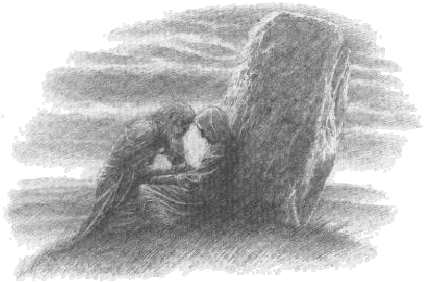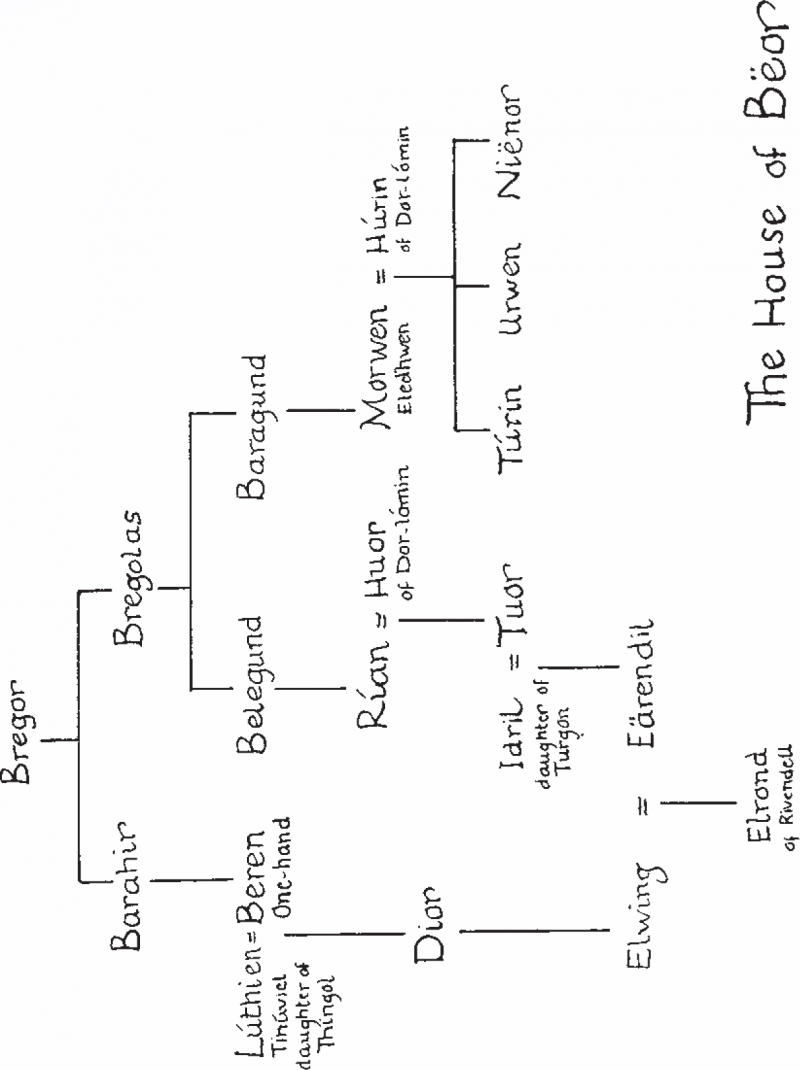
But Túrin sped far before them, and came to Cabeden-Aras, and stood still; and he heard the roaring of the water, and saw that all the trees near and far were withered, and their sere leaves fell mournfully, as though winter had come in the first days of summer.
‘Cabed-en-Aras, Cabed Naeramarth!’ he cried. ‘I will not defile your waters where Níniel was washed. For all my deeds have been ill, and the latest the worst.’
Then he drew forth his sword, and said: ‘Hail Gurthang, iron of death, you alone now remain! But what lord or loyalty do you know, save the hand that wields you? From no blood will you shrink. Will you take Túrin Turambar? Will you slay me swiftly?’
And from the blade rang a cold voice in answer: ‘Yes, I will drink your blood, that I may forget the blood of Beleg my master, and the blood of Brandir slain unjustly. I will slay you swiftly.’
Then Túrin set the hilts upon the ground, and cast himself upon the point of Gurthang, and the black blade took his life.
But Mablung came and looked on the hideous shape of Glaurung lying dead, and he looked upon Túrin and was grieved, thinking of Húrin as he had seen him in the Nirnaeth Arnoediad, and the dreadful doom of his kin. As the Elves stood there, men came down from Nen Girith to look upon the Dragon, and when they saw to what end the life of Túrin Turambar had come they wept; and the Elves learning at last the reason of Túrin’s words to them were aghast. Then Mablung said bitterly: ‘I also have been meshed in the doom of the Children of Húrin, and thus with words have slain one that I loved.’
Then they lifted up Túrin, and saw that his sword was broken asunder. So passed all that he possessed.
With toil of many hands they gathered wood and piled it high and made a great burning and destroyed the body of the Dragon, until he was but black ash and his bones beaten to dust, and the place of that burning was ever bare and barren thereafter. But Túrin they laid in a high mound where he had fallen, and the shards of Gurthang were set beside him. And when all was done, and the minstrels of Elves and Men had made lament, telling of the valour of Turambar and the beauty of Níniel, a great grey stone was brought and set upon the mound; and thereon the Elves carved in the Runes of Doriath:
TÚRIN TURAMBAR DAGNIR GLAURUNGA
and beneath they wrote also:
NIËNOR NÍNIEL
But she was not there, nor was it ever known whither the cold waters of Teiglin had taken her.
Here ends the Tale of the Children of Húrin, longest of all the lays of Beleriand.
After the deaths of Túrin and Niënor Morgoth released Húrin from bondage in furtherance of his evil purpose. In the course of his wanderings he reached the Forest of Brethil, and came up in the evening from the Crossings of Teiglin to the place of the burning of Glaurung and the great stone standing on the brink of Cabed Naeramarth. Of what befell there this is told.
But Húrin did not look at the stone, for he knew what was written there; and his eyes had seen that he was not alone. Sitting in the shadow of the stone there was a figure bent over its knees. Some homeless wanderer broken with age it seemed, too wayworn to heed his coming; but its rags were the remnants of a woman’s garb. At length as Húrin stood there silent she cast back her tattered hood and lifted up her face slowly, haggard and hungry as a long-hunted wolf. Grey she was, sharp-nosed with broken teeth, and with a lean hand she clawed at the cloak upon her breast. But suddenly her eyes looked into his, and then Húrin knew her; for though they were wild now and full of fear, a light still gleamed in them hard to endure: the elven-light that long ago had earned her her name, Eledhwen, proudest of mortal women in the days of old.
‘Eledhwen! Eledhwen!’ Húrin cried; and she rose and stumbled forward, and he caught her in his arms.
‘You come at last,’ she said. ‘I have waited too long.’ ‘It was a dark road. I have come as I could,’ he answered. ‘But you are late,’ she said, ‘too late. They are lost.’
‘I know,’ he said. ‘But you are not.’
‘Almost,’ she said. ‘I am spent utterly. I shall go with the sun. They are lost.’ She clutched at his cloak. ‘Little time is left,’ she said. ‘If you know, tell me! How did she find him?’
But Húrin did not answer, and he sat beside the stone with Morwen in his arms; and they did not speak again. The sun went down, and Morwen sighed and clasped his hand and was still; and Húrin knew that she had died.

GENEALOGIES



APPENDIX
These interrelated but independent stories had from far back stood out from the long and complex history of Valar, Elves and Men in Valinor and the Great Lands; and in the years that followed his abandonment of the Lost Tales before they were completed my father turned away from prose composition and began work on a long poem with the title Túrin son of Húrin and Glórund the Dragon, later changed in a revised version to The Children of Húrin. This was in the earlier 1920s, when he held appointments at the University of Leeds. For this poem he employed the ancient English alliterative metre (the verse form of Beowulf and other Anglo-Saxon poetry), imposing on modern English the demanding patterns of stress and ‘initial rhyme’ observed by the old poets: a skill in which he achieved great mastery, in very different modes, from the dramatic dialogue of The Homecoming of Beorhtnoth to the elegy for the men who died in the battle of the Pelennor Fields. The alliterative Children of Húrin was by far the longest of his poems in this metre, running to well over two thousand lines; yet he conceived it on so lavish a scale that even so he had reached no further in the narrative than the assault of the Dragon on Nargothrond when he abandoned it. With so much more of the Lost Tale still to come it would have needed on this scale many more thousands of lines; while a second version, abandoned at an earlier point in the narrative, is about double the length of the first version to that same point.
In that part of the legend of the Children of Húrin that my father achieved in the alliterative poem the old story in The Book of Lost Tales was substantially extended and elaborated. Most notably, it was now that the great underground fortress-city of Nargothrond emerged, and the wide lands of its dominion (a central element not only in the legend of Túrin and Niënor but in the history of the Elder Days of Middle-earth), with a description of the farmlands of the Elves of Nargothrond that gives a rare suggestion of the ‘arts of peace’ in the ancient world, such glimpses being few and far between. Coming south along the river Narog Túrin and his companion (Gwindor in the text in this book) found the lands near the entrance to Nargothrond to all appearance deserted: